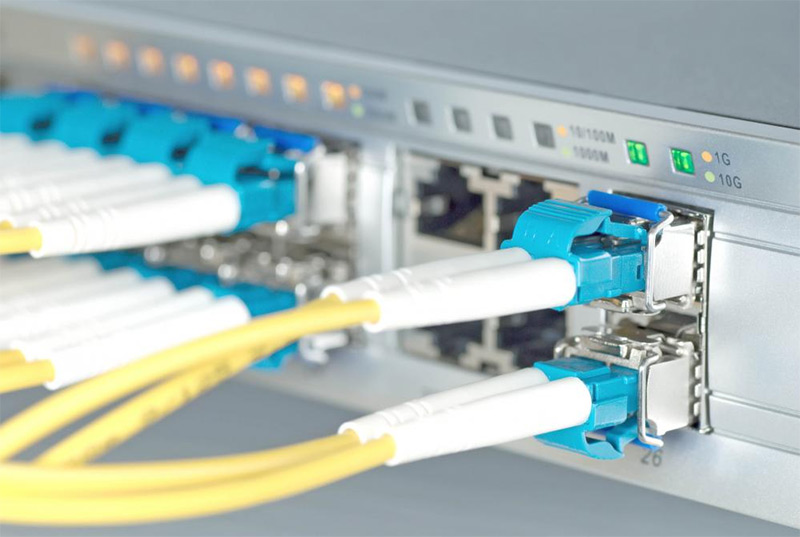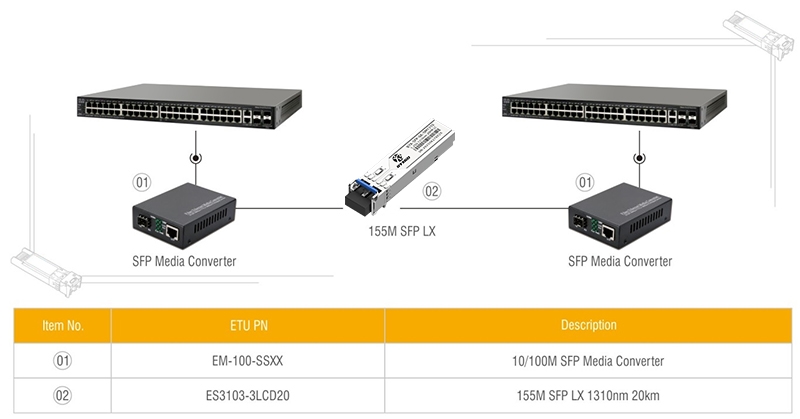Have you ever endured sluggish network performance or expensive connectivity problems that were hampering your company’s progress? The right optical transceiver module can enhance your network performance; you will enjoy superior data flow speeds and reliable connectivity for little or no additional cost. The following article will describe the important types of optical transceivers, so you will know which optical transceiver module fits the needs of your unique network environment. As you identify some exciting options and review some key parameters of what to look for when selecting an optical transceiver, you will be comfortable and confident in your efforts to optimize your infrastructure while scaling as your data requirements increase.
Optical Transceiver Modules For Sale
 What Are Optical Transceivers? The Core of Modern Networks
What Are Optical Transceivers? The Core of Modern Networks
Optical transceivers are vital components that convert electrical signals into optical signals and exchange them in a two-way manner to enable high-speed data transmission in fiber optic networks. As the communication link, these modules provide fast and reliable connections that are essential to network infrastructures today. By efficiently sending and receiving data, fiber optic transceivers improve the overall performance of the network while reducing latency. By their very nature, transceivers also allow for expansion as demand changes, which keeps costs under control while having the capability to expand networks without requiring hardware changes.
Optical modules are similar to translators that convert electrical traffic into light signals and allow data to travel at top speeds over great distances. Transceivers are at the center of building scalable and cost-efficient networks that support growing digital workloads.
Explore Our Foundational Optical Transceiver Categories
Are you unsure of the many kinds of optical transceivers? Selecting the right module can seem like a complicated maze without a map.
In this section, we will categorize each family with clear names and benefits to help you quickly identify the kind of optical transceiver that matches the requirements of your network. Read on for clarity and comfort in choosing the ideal connectivity solution.
SFP Modules: The 1G Workhorse
SFP modules are the basic structure for network design, broadly known to provide dependable 1G connectivity. Their simplicity and flexibility make them integral to basic enterprise and telecom infrastructures.
These fiber optic transceivers allow interconnectivity between switches, routers, and servers to support many types of fiber and distances. The form factor and power consumption allow for dense port arrangements while keeping hardware design simple.
SFP modules can be viewed as the dependable workhorses in your network, commonly used for everyday data traffic while allowing potential upgrades.
SFP+ Modules: The 10G Upgrade Hero
SFP+ modules are the ideal mixture of price and performance for upgrading enterprise networks to 10G. They are the bridge between basic 1G connections and high-speed requirements. These versatile fiber optic transceivers allow highly reliable data rates of up to 10 gigabits per second and work across distances and fiber types. SFP+ modules have a small form factor and low power consumption, enabling them to stack as densely as possible without overheating or topping out on power consumption.
You can think of SFP+ modules as the turbo boost for the network. They give you speed upgrades without destroying the budget.
25G SFP28 Modules: The 25G Data Center Backbone
In modern data centers, 25G SFP28 modules are becoming increasingly important to facilitate high-speed, low-latency connections, which are essential for virtual services in the cloud. SFP28 modules increase network capacity without requiring large power budgets or rack space.
25G optical modules support 25 Gigabit Ethernet speeds and facilitate a smooth migration from the 10G upgrade path to 25G performance levels for applications that require higher performance. 25G SFP28 modules also work readily with existing SFP infrastructure to engage the technology successfully. The 25G SFP28 module is a leading candidate for backbone technology where a data center implements next-generation services.
Think of 25G SFP28 modules as dedicated power lanes in the road network of a big city; they allow for increased traffic capacity and rapid traversal through the network to keep data flowing efficiently and reliably.
40G QSFP+ Modules: The High-Density Aggregator
40G QSFP+ modules are designed to aggregate traffic from multiple links of lesser speed into an uplink of higher capacity. They are particularly important in large switching environments where efficient bandwidth consumption is a requirement.
40G QSFP+ modules can be configured to operate at 40 Gigabit Ethernet speeds and support high-density port configurations without sacrificing performance. Because they can be used with existing infrastructure, they have become a logical choice in data centers and optical fiber networks dealing with large bandwidths.
Ultimately, you can think of 40G QSFP+ modules as major traffic junctions in your network that provide smoother merging and conversion of bandwidth for fast, reliable data transmission.
100G QSFP28 Modules: The 100G Core Powerhouse
100G QSFP28 modules provide the performance level necessary for backbone-level central network switches and routers. 100G QSFP28 modules enable extremely fast data transfers that keep pace with the requirements of very large enterprise and service provider networks.
The modules are of 100 Gigabit Ethernet design, which increases the bandwidth density of the system while being power efficient. The design of the modules works with existing systems, allowing seamless scalability based on growing traffic.
Think of the 100G QSFP28 modules as the electric power plant of your network—providing reliable service to significant data flows alongside energy-efficient methods.

Looking Ahead: The Future of Optical Transceivers with QSFP56
QSFP56 modules are the next generation of high-speed optical transceivers supporting speeds of 50G and 200G while serving the demands of increasing network bandwidth in the future. Positioned as future technology, they prepare infrastructure to grow without replacing the basic types of transceivers.
These modules are not just faster implementations; they are designed with better power efficiency and improved signal integrity, which makes them flexible enough for either data center applications or telecom applications. They provide a stable solution to easily scale past, present, and future network standards with ease.
QSFP56 modules can be thought of as the multi-dimensional athlete who tackles tomorrow’s challenges while keeping your network implementation updated. To understand the technology behind these modules or learn to compare them, utilize our QSFP56 vs QSFP28 Comparison.
Expert Resources to Assist with Selection & Troubleshooting
Navigating through choices of optical transceivers can appear complicated, but tailored resources can take you through common problems, keeping you educated in effective troubleshooting.
- Optical Transceiver Selection Guide: It provides a thoughtful framework to balance speed, distance, and compatibility, helping to avoid expensive mistakes at the time of purchase. For a deeper understanding, see: Data Center 10G SFP+ Module: Choosing the Right 10G Module for Network Upgrade.
- Exclusive Case Study: Successful QSFP28 Network Upgrade: A firsthand experience of a successful transformation, including challenges faced and return on investment earned. Read the case study.
- Troubleshooting Optical Modules: Useful guide detailing—step-by-step—resolutions to common issues, such as signal loss, overheating, and more, keeping disruption to your network as little as possible. Learn more here
- Compatibility: Articles to avoid vendor mistakes so you can be sure the modules will play nice while working with major vendors, such as Cisco, Juniper, Huawei, and more. For deeper information, see Cisco SFP Compatibility and Unlock Juniper SFP Compatibility
- Glossary and Technical Terminology: Breaks down complex terms and establishes confidence in purchasing and deploying optical transceivers.
- QSFP56 versus QSFP28 Comparison: Examines the latest specifications and power efficiency of transceivers to assist you in strategically planning your future-proof upgrade. For deeper information, see QSFP28 and QSFP56 Specifications Comparison
These resources allow network professionals to make knowledgeable decisions, deploy effectively, and work with confidence when maintaining optimal performance levels in their networks.

Frequently Asked Questions
SFP modules support up to 1G speeds and are used for basic network needs. SFP+ doubles the previous SFP speed and supports 10G connections in high-demand environments. For more in-depth information, view 1000BASE-SFP Modules and 10G SFP+ Modules.
You should consider bandwidth needs, distance, and compatibility with existing hardware. Striking the right balance will produce effective and future-proof deployments. For deeper information, see Choosing the Right 10G Module for Network Upgrade
25G SFP28 modules provide a pathway to 25G Ethernet and more available bandwidth without heavy infrastructure costs. For deeper information, see 25G SFP28 Modules
QSFP56 modules support speeds of 50G or 200G and have better power efficiency and increased capacity, preparing your network for future growth. For deeper information, see QSFP56 vs QSFP28.
Third-party transceivers are usually fine if they are of good quality, but you should ensure they comply with your warranties and verify compatibility beforehand. For deeper information, see OEM vs Aftermarket Cisco SFP Modules and Cisco SFP Compatibility.
In BiDi transceivers, the same fiber is used for sending and receiving data by using different wavelengths to double fiber utilization, making it a good option when fiber is scarce. For deeper information, see BiDi Optical Modules: Unlocking Single-Fiber Bidirectional Connectivity.
Start by checking all physical connections, making sure the firmware is the same, or replacing a broken transceiver. For deeper information, see Troubleshooting and Repairing Optical Transceiver Failures in SFP/SFP+ Modules.
CWDM uses wider channel spacing and is a cost-effective choice for connecting at short to medium distances. DWDM has channels packed more densely and is typically used for long-haul and high-capacity networks. For deeper information, see CWDM vs DWDM Optical Modules.
Cleaning your connectors periodically and taking proper precautions can help prevent signal loss and damage to hardware. For deeper information, see Optical Module Maintenance and Cleaning.
Since no vendor is the same, firmware and hardware can vary, so always check with a vendor’s compatibility list or documentation. For deeper information, see Cisco SFP Compatibility, Unlock Juniper SFP Compatibility and Aruba, Ubiquiti & Fortinet SFP Compatibility Guide.
It helps to familiarize yourself with part number conventions to get a sense of module capabilities and compatibility. For deeper information, see Cisco SFP Module Part Number Decoding.
The primary reasons for failure are overheating, physical damage, or lack of cleanliness (dust). Control the environment and regularly service equipment to mitigate risks. For deeper information, see Optical Module Failure Diagnosis and Prevention.
Contact Us For The Best Solution
Purchasing the right optical transceivers can help improve your network stability, scalability, and cost savings.
You will have more than a wide selection of high-quality transceivers but also additional support from our team of experts for seamless network upgrades.

 What Are Optical Transceivers? The Core of Modern Networks
What Are Optical Transceivers? The Core of Modern Networks